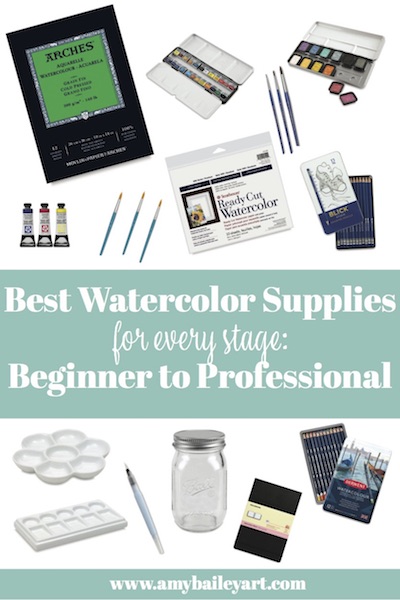
To make this easy to follow, I’m breaking watercolor supplies into three categories. They are (1) most affordable for beginners,(2) more mid-range and student grade for hobbyists, and (3)Professional grade supplies, which are also usually my favorite supplies and ones I use most, particularly for professional purposes. Hopefully this makes sense, but as always please reach out with questions if not!
*Note: I hope this is obvious but just in case – these choices are based on my personal experience and opinion. I am not suggesting there are not other wonderful options also available. In fact, if you have favorite watercolor supplies I failed to mention here please share in the comments so we can all check it out! Thank you!
Paints:
Watercolors come in pans and tubes. Which you choose is all about personal preference. Tubes contain liquid watercolor pigment that you squeeze out onto your palette. They are easy to mix and work well for larger paintings, but they can dry out and require set up. Pans are cake-like blocks of dry watercolor pigment. They tend to last longer, usually come with their own mixing palette, are portable and great for travel. However, you have to work a little harder to activate the paint, which makes them less ideal for larger work . I love and use both. For my everyday, personal creative practice I use the pan set linked below. I tend to take out my tubes for larger work or commissions.
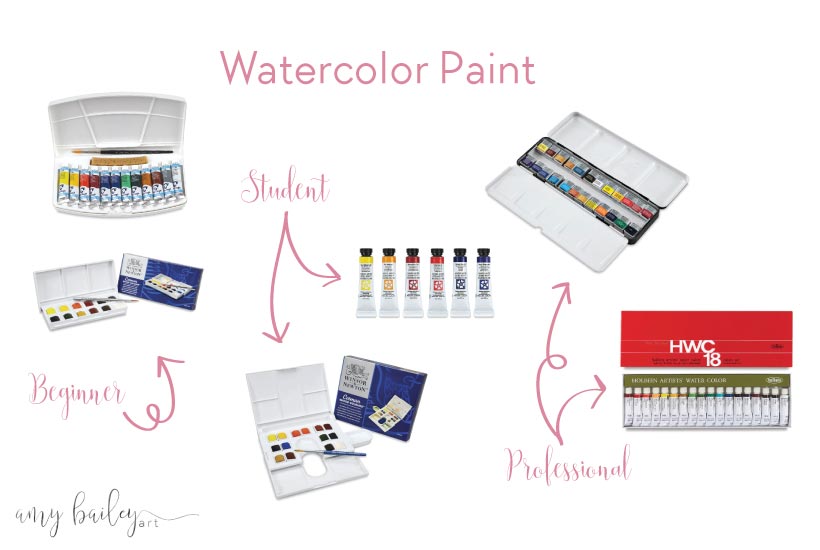
- Beginner – Van Gogh Watercolors Set of 12, 10 ml tubes and Winsor & Newton Cotman Sketcher’s Pocket Box, Set of 12 Half Pans
- Student – Daniel Smith Extra Fine Watercolor Essentials Set, 5 ml Tube and Winsor & Newton Cotman Watercolors Compact Set Set of 14 Half pans
- Professional – Holbein Artists’ Watercolors Set of 18, 5 ml tubes and Winsor & Newton Professional Watercolor – Lightweight Sketchers’ Box Half Pan Set of 24
If you go with tubes for you watercolor supplies, having a covered palette like this for set up is helpful!
Paper:
Weight is important because lighter papers may buckle, warp or wrinkle when wet. It is hard to learn a new medium while fighting these factors. You can save some money by using 140lb paper which is still good to work on but might need stretching beforehand, but you can avoid stretching by taping the paper to a board. I like to use foam board and this painter’s tape. Heavy paper (300-400 lb/600-850 gsm) can absorb more water and rarely needs stretching. Light paper is anything less than 140 lb/300 gsm.
There are three types of textures of paper:
- Rough – heavy texture, most absorbent.
- Cold press – medium texture and absorbency, adds some visual texture.
- Hot press – no texture, smooth, low absorbency.
For me cold press paper offers the best of both worlds, and it’s my top recommendation. Here are my favorites with links to my favorite place to buy art supplies.
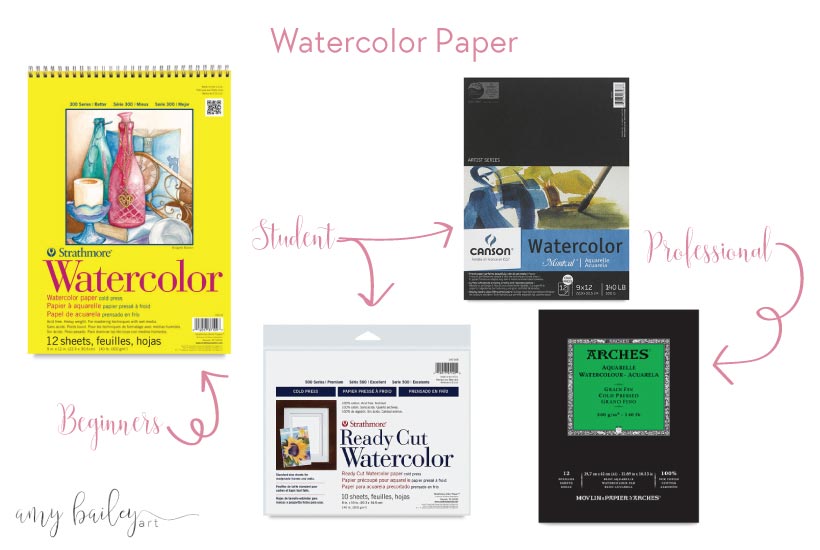
- Beginners – Strathmore 300 Series Student Watercolor Pad
- Student – Strathmore Ready Cut Watercolor Sheets and Canson Montval Watercolor Pads
- Professional grade – Arches Watercolor Pad, 140 lb (300 gsm), cold press
Paint Brushes:
This might be the most confusing of watercolor supplies. Let’s try to keep it simple. Once you have spent time getting to know this medium, you will discover your favorite brush by using it. Quality is important, but you will most likely be able to create your desired effects using 2-4 of your favorite brushes because they allow you to control the paint in a way that is comfortable for you. So instead of buying a huge expensive brush set with fancy brushes that do only one specific task, I recommend having about 5 multipurpose that you actually use often. My favorite brush is one that I inherited from my grandfather and all the words are completely rubbed off. But, I’m sure that it is a round brush and my guess is it’s a size 2 or 3.
My recommendation for getting started would be 3 or 4 round brushes in varying sizes, and a 3/4″ or 1″ flat brush for larger spaces. But, if you see another kind or size that intrigues you follow your intuition!
Round brushes are by far the most versatile. Currently, much of my work is small so my go to’s are 1, 3, 6 and 8. If you are wanting to work larger, scale up.
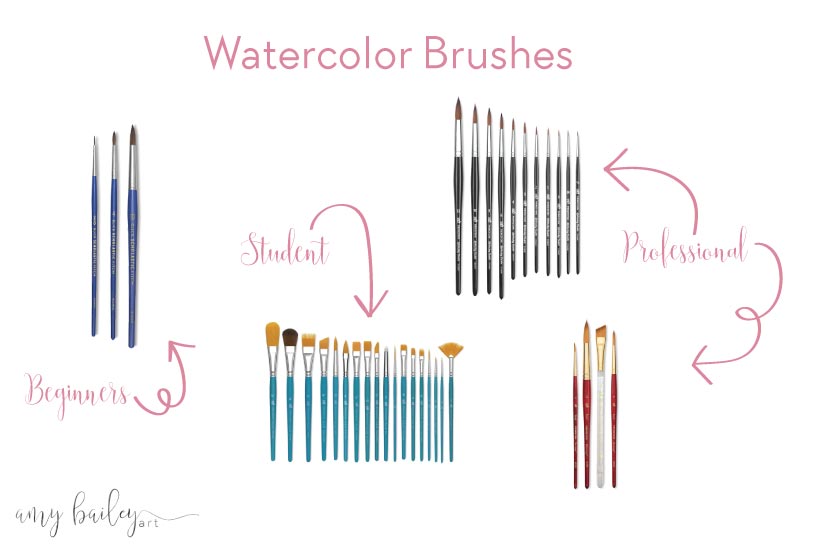
- Beginner – Blick Scholastic Pony Brushes
- Student – Princeton Select Series 3750
- Professional – Princeton Heritage Series 4050
- Worth the splurge – Princeton Siberia Series 7050
Be sure to scroll down on the brush product pages linked here. The link will take you to the collection and you can find individual brushes listed below the product information.
Here are some necessary watercolor supplies you may already have on hand:
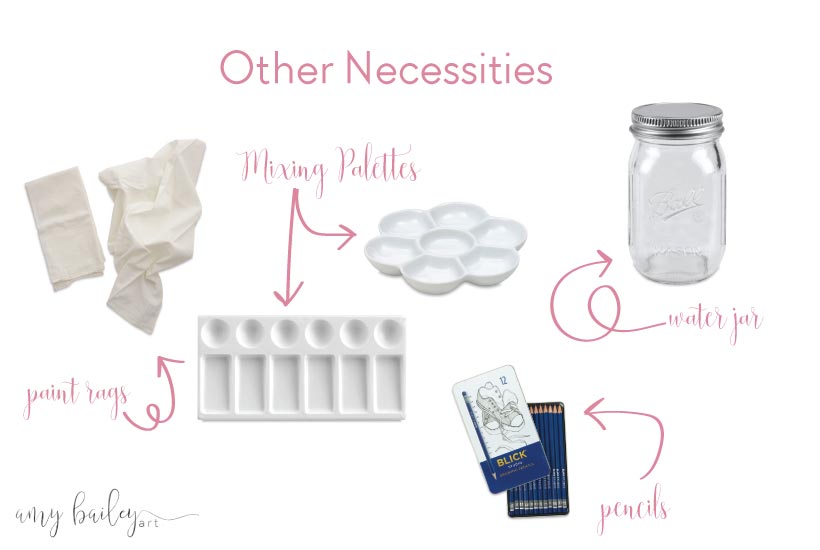
- Water jars – I use glass ball jars
- Towels/paint rags – I use worn out kitchen towels but I also have some of these 100% cotton towels that work well.
- Palettes for mixing – Plastic is more affordable and less breakable, but this porcelain flower is my favorite and worth the little extra because paints stay moist longer, colors appear true, and clean up is quick and easy.
- Pencils – You need these for sketching the underdrawing. You can use any pencils you have, but I linked a quality, affordable drawing pencil set. I like to use a very hard lead (usually 4H or 6H) so there is less graphite that could mix with your paint.
- Don’t forget to have foam board and painter’s tape to prevent buckling paper.
Bonus Watercolor Supplies Just for fun:
Here are some more options for you that go beyond the basic supplies. These are all fun and useful additions for your watercolor exploration journey.
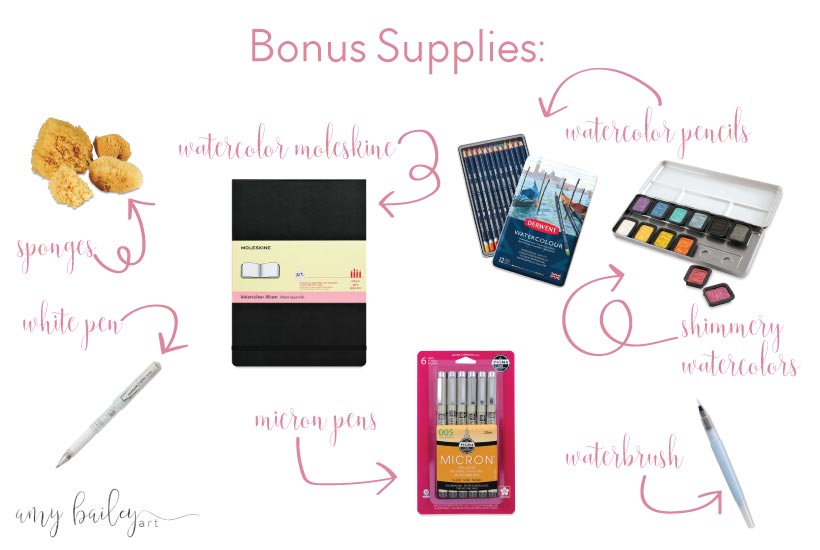
- Sponge – Royal Super Value Sponge Set. You can use this to create fun texture and effects.
- White pen – This Uni-ball signo gel pen is amazing. I’ve tried many many many white pens and this is my favorite to date. It’s really fun to use to add white details to dry watercolor paintings!
- Small watercolor sketchbook – I use my small watercolor sketchbook almost daily and it brings me so much joy! I love this moleskine folio. Just be sure to scroll down to select watercolor paper.
- Archival quality pigma pens – Sakura Pigma Micron Pens. These are great for adding detail or if you want to create an illustrative quality.
- Finetec Artist Mica Watercolors – these watercolors have mica which gives them natural shimmer and shine.
- Waterbrush – Sakura Koi Water Brushes are really convenient to have for watercoloring outdoors. It holds the water in the brush for you! Amazing!
- Watercolor pencils – These Derwent Watercolor pencils are professional-quality watersoluble pencils. They allow you to switch from drawing to painting without changing tools. You can use them on dry paper, then wash over with brush and water to blend or on wet paper for a rich color and sharp edge.
There you have it! Watercolor supplies for every stage of your journey. I hope you have found this helpful. Happy creating!
(This post may contain some affiliate links, but all opinions are my own. Any compensation I may receive helps with expenses to keep this blog up and running! Thank you for your support!)

